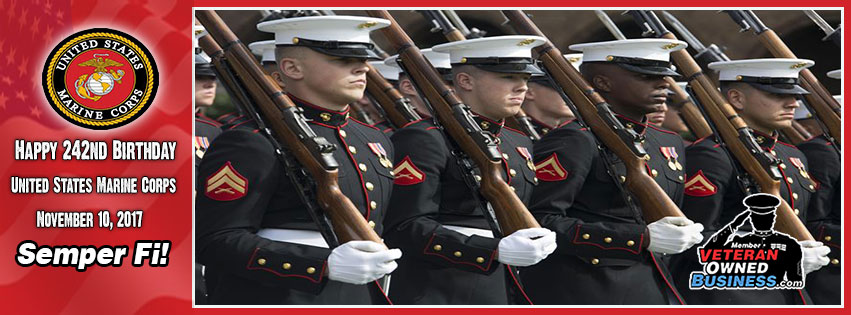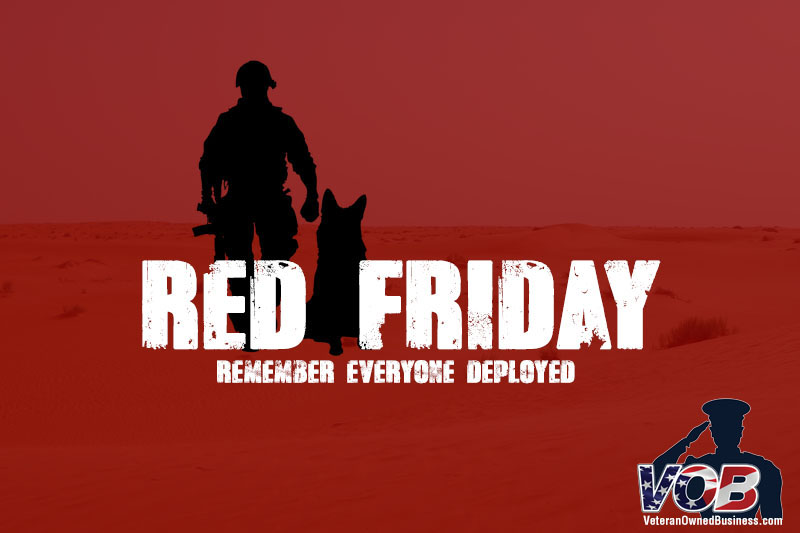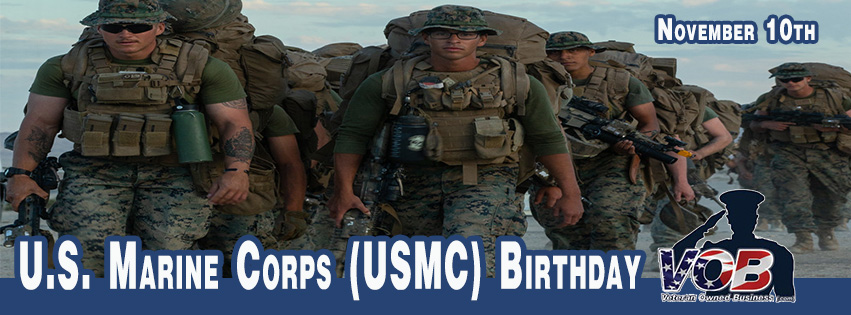Semper Fi! Happy 242nd Birthday United States Marine Corps!
 We say a special “thank you” to our brothers and sisters who have and continue to serve in the United States Marine Corps
We say a special “thank you” to our brothers and sisters who have and continue to serve in the United States Marine Corps
Thank you for your service!
View businesses owned by Marine Corps veterans
View United States Marine Corps (USMC) History
View United States Marine Corps Quotes
A Tribute To The USMC
The United States Marine Corps (USMC) is a branch of the United States Armed Forces responsible for providing power projection from the sea, using the mobility of the United States Navy to deliver combined-arms task forces rapidly. It is one of seven uniformed services of the United States. In the civilian leadership structure of the United States military, the Marine Corps is a component of the United States Department of the Navy, often working closely with U.S. naval forces for training, transportation, and logistic purposes; however, in the military leadership structure the Marine Corps is a separate branch.
Captain Samuel Nicholas formed two battalions of Continental Marines on 10 November 1775 in Philadelphia as naval infantry. Since then, the mission of the Marine Corps has evolved with changing military doctrine and American foreign policy. The Marine Corps has served in every American armed conflict and attained prominence in the 20th century when its theories and practices of amphibious warfare proved prescient and ultimately formed the cornerstone of the Pacific campaign of World War II. By the mid-20th century, the Marine Corps had become the dominant theorist and practitioner of amphibious warfare. Its ability to rapidly respond on short notice to expeditionary crises gives it a strong role in the implementation and execution of American foreign policy.
As of 2010 the United States Marine Corps included just under 203,000 active duty marines and just under 40,000 reserve marines. It is the smallest of the United States’ armed forces in the U.S. Department of Defense (DoD). The United States Coast Guard is smaller, about one-fifth the size of the Marine Corps, but it does not normally operate under the DoD. The Marine Corps is nonetheless larger than the armed forces of many significant military powers; it is larger than the active duty Israel Defense Forces and the active duty British Army for example.
Mission
The USMC serves as an expeditionary force-in-readiness. As outlined in 10 U.S.C. § 5063 and as originally introduced under the National Security Act of 1947, it has three primary areas of responsibility:
- The seizure or defense of advanced naval bases and other land operations to support naval campaigns;
- The development of tactics, technique, and equipment used by amphibious landing forces in coordination with the Army and Air Force; and
- Such other duties as the President may direct.
This last clause, while seemingly redundant given the President’s position as Commander-in-chief, is a codification of the expeditionary duties of the Marine Corps. It derives from similar language in the Congressional acts “For the Better Organization of the Marine Corps” of 1834, and “Establishing and Organizing a Marine Corps” of 1798. In 1951, the House of Representatives’ Armed Services Committee called the clause “one of the most important statutory – and traditional – functions of the Marine Corps.” It noted that the corps has more often than not performed actions of a non-naval nature, including its famous actions in Tripoli, the War of 1812, Chapultepec, and numerous counter-insurgency and occupational duties (such as those in Central America), World War I, and the Korean War. While these actions are not accurately described as support of naval campaigns nor as amphibious warfare, their common thread is that they are of an expeditionary nature, using the mobility of the Navy to provide timely intervention in foreign affairs on behalf of American interests.
In addition to its primary duties, the Marine Corps has missions in direct support of the White House and the State Department. The Marine Band, dubbed the “President’s Own” by Thomas Jefferson, provides music for state functions at the White House. Marines from Ceremonial Companies A & B, quartered in Marine Barracks, Washington, D.C., guard presidential retreats, including Camp David, and the Marines of the Executive Flight Detachment of HMX-1 provide helicopter transport to the President and Vice President, with the call signs “Marine One” and “Marine Two,” respectively. By authority of the 1946 Foreign Service Act, the Marine Security Guards of the Marine Embassy Security Command provide security for American embassies, legations, and consulates at more than 140 posts worldwide.
Capabilities
The Marine Corps fulfills a vital role in national security as an amphibious, expeditionary, air-ground combined arms task force, capable of forcible entry from the air, land, and sea. It is capable of asymmetric warfare with conventional, irregular, and hybrid forces.
While the Marine Corps does not employ any unique combat arms, as a force it can rapidly deploy a combined-arms task force to almost anywhere in the world within days. The basic structure for all deployed units is a Marine Air-Ground Task Force (MAGTF) that integrates a ground combat element, an aviation combat element and a logistics combat element under a common command element. While the creation of joint commands under the Goldwater–Nichols Act has improved inter-service coordination between each branch, the Corps’ ability to permanently maintain integrated multi-element task forces under a single command provides a smoother implementation of combined-arms warfare principles.
The close integration of disparate Marine units stems from an organizational culture centered around the infantry. Every other Marine capability exists to support the infantry. Unlike some Western militaries, the Corps remained conservative against theories proclaiming the ability of new weapons to win wars independently. For example, Marine aviation has always been focused on close air support and has remained largely uninfluenced by air power theories proclaiming that strategic bombing can single-handedly win wars.
This focus on the infantry is matched with the doctrine that “Every Marine is a rifleman”, a focus of Commandant Alfred M. Gray, Jr., emphasizing the infantry combat abilities of every Marine. All Marines, regardless of military specialization, receive training as a rifleman; and all officers receive additional training as infantry platoon commanders. For example, at Wake Island, when all of the Marine aircraft were shot down, pilots continued the fight as ground officers, leading supply clerks and cooks in a final defensive effort. As a result, a large degree of initiative and autonomy is expected of junior Marines, particularly the NCOs (corporals and sergeants), as compared with many other military organizations. The Marine Corps emphasizes authority and responsibility downward to a greater degree than the other military services. Flexibility of execution is implemented via an emphasis on “commander’s intent” as a guiding principle for carrying out orders; specifying the end state but leaving open the method of execution. The amphibious assault techniques developed for World War II evolved, with the addition of air assault and maneuver warfare doctrine, into the current “Operational Maneuver from the Sea” doctrine of power projection from the seas. The Marines are credited with the development of helicopter insertion doctrine and were the earliest in the American military to widely adopt maneuver-warfare principles which emphasize low-level initiative and flexible execution. In light of recent warfare that has strayed from the Corps’ traditional missions, it has renewed an emphasis on amphibious capabilities.
The Marine Corps relies on the Navy for sealift to provide its rapid deployment capabilities. In addition to basing a third of the Fleet Marine Force in Japan, Marine Expeditionary Units (MEU) are typically stationed at sea. This allows the ability to function as first responders to international incidents. The United States Army now maintains light infantry units capable of rapid worldwide deployment, but those units do not match the combined-arms integration of a MAGTF and lack the logistics that the Navy provides. For this reason, the Marine Corps is often assigned to non-combat missions such as the evacuation of Americans from unstable countries and providing humanitarian relief during natural disasters. In larger conflicts, Marines act as a stopgap, to get into and hold an area until larger units can be mobilized. The Corps performed this role in World War I and the Korean War, where Marines were the first significant combat units deployed from the United States and held the line until the country could mobilize for war. To aid rapid deployment, the Maritime Pre-Positioning System was developed: fleets of container ships are positioned throughout the world with enough equipment and supplies for a Marine Expeditionary Force to deploy for 30 days.
The USMC is planning to reduce its logistical requirements and by 2025 eliminate all liquid fuel use for Marine Expeditionary Forces, except for highly efficient vehicles.









